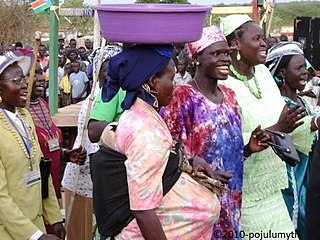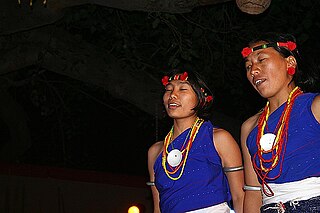In finance, a swap is an agreement between two counterparties to exchange financial instruments, cashflows, or payments for a certain time. The instruments can be almost anything but most swaps involve cash based on a notional principal amount.
Prior to 1904, the Bilibil people lived on an island offshore from Madang, Papua New Guinea, trading clay pots along the coast from Karkar Island to western Morobe Province. The island was too small to produce enough food for the inhabitants, and the trade therefore was an essential element of their life. They moved to the mainland to their existing village site to improve their subsistence levels. They speak the Bilibil language, an Austronesian language.

The Bari are a tribe of South Sudan in East Africa they are Nilotic people inhabiting South Sudan. The Bari speak the Bari language as a mother tongue, which belongs to the Nilotic family.

Khonds are an indigenous Adivasi tribal community in India. Traditionally hunter-gatherers, they are divided into the hill-dwelling Khonds and plain-dwelling Khonds for census purposes, but the Khonds themselves identify by their specific clans. Khonds usually hold large tracts of fertile land, but still practice hunting, gathering, and slash-and-burn agriculture in the forests as a symbol of their connection to, and as an assertion of their ownership of the forests wherein they dwell. Khonds speak the Kui language and write it in the Odia script.

The Hmong people are an ethnic group currently native to several countries, believed to have come from the Yangtze river basin area in southern China. The Hmong are known in China as the Miao, which encompasses not only Hmong, but also other related groups such as Hmu, Qo Xiong and A-Hmao. There is debate about usage of this term, especially amongst Hmong living in the West, as it is believed by some to be derogatory, although Hmong living in China still call themselves by this name. Throughout recorded history, the Hmong have remained identifiable as Hmong because they have maintained the Hmong language, customs, and ways of life while adopting the ways of the country in which they live. In the 1960s and 1970s, many Hmong were secretly recruited by the American CIA to fight against communism during the Vietnam War. After American armed forces pulled out of Vietnam the Pathet Lao, a communist regime, took over in Laos and ordered the prosecution and re-education of all those who had fought against its cause during the war. While many Hmong are still left in Laos, Thailand, Vietnam, Myanmar, and China, since 1975 many Hmong have fled Laos in fear of persecution. Housed in Thai refugee camps during the 1980s, many have resettled in countries such as the United States, French Guiana, Australia, France, Germany, as well as some who have chosen to stay in Thailand in hope of returning to their own land. In the United States, new generations of Hmong are gradually assimilating into American society while being taught Hmong culture and history by their elders. Many fear that as the older generations pass on, the knowledge of the Hmong among Hmong Americans will die as well.
The Kombai are a Papuan people living in the Indonesian province of South Papua, more specifically in Mappi Regency. Their total population is about 5,650.
Reang is one of the Tripuri clan of the Northeast Indian state. The Reangs can be found all over the Tripura state in India. However, they may also be found in Assam and Mizoram. They speak the Kokborok language.

The Turu are an ethnic and linguistic group based in the Singida Region of north-central Tanzania who speak Bantu language Kinyaturu. In 1993, the Turu population was estimated to number 556,000. The current population of the Turu is now over 1,000,000. They speak the Turu language.

Sister exchange is a type of marriage agreement where two sets of siblings marry each other. In order to get married, a man needs to persuade his sister to marry the bride's brother. It is practised as a primary method of organising marriages in 3% of the world's societies: in Australia, Melanesia, Amazonia and Sub-Saharan Africa; and can replace other methods in 1.4% of the societies.

The Kisan are a tribal group found in Odisha, West Bengal and Jharkhand. They are traditional farmers and a food gathering people. They speak Kisan, a dialect of Kurukh, as well as Odia and Sambalpuri. The tribe mainly lives in northwestern Odisha, in the districts of Sundergarh, Jharsuguda and Sambalpur. Other populations live in Malda district in western West Bengal and Latehar and Gumla districts of western Jharkhand. They also reside in Nepal's Jhapa district in small number(around 1000).
The term asset swap has a number of different meanings:

The Pojulu is a tribe of the savanna lands in the White Nile Valley, in the Equatoria region of South Sudan. They are Nilotic people and part of the Karo people — which also includes Bari, Mundari, Kakwa, Kuku, Nyangwara, and the Karo Tribes Of Omo Valley in Ethiopia such as the Banna, Hamer, Mursi, Kara, Dassanech, Arbore, Nyangatom known as the Omo Karo peoples.

The Xhosa people, or Xhosa-speaking people are a Bantu ethnic group native to South Africa and they are the second largest ethnic group in Southern Africa and are native speakers of the IsiXhosa language.
Jimi is a geographical area in the inlands of Papua New Guinea. It is located in the Jimi District of Jiwaka, which was previously a part of the Western Highlands Province until May 2012. It is home to the Jimi Valley. The Jimi District is one of the least developed districts in Papua New Guinea, apart from Green River in Sandaun and Rai Coast in Madang. Its geographical location makes it a remote district of the newly-created Jiwaka province. The district is located in the Jimi Valley, which stretches from the northeast corner of Jiwaka and into Madang Province.

The Kaluli are a clan of indigenous peoples who live in the rain forests of the Great Papuan Plateau in Papua New Guinea. The Kaluli, who numbered approximately 2,000 people in 1987, are the most numerous and well documented by post-contact ethnographers and missionaries among the four language-clans of Bosavi kalu that speak non-Austronesian languages. Their numbers are thought to have declined precipitously following post-contact disease epidemics in the 1940s, and have not rebounded due to high infant mortality rates and periodic influenza outbreaks. The Kaluli are mostly monolingual in an ergative language.

The Pochurys are a Naga ethnic group inhabiting the Northeast Indian state of Nagaland. They mostly live in the eastern part of the Phek district, centered at Meluri town.

Bride price, bride-dowry, bride-wealth, bride service or bride token, is money, property, or other form of wealth paid by a groom or his family to the woman or the family of the woman he will be married to or is just about to marry. Bride dowry is equivalent to dowry paid to the groom in some cultures, or used by the bride to help establish the new household, and dower, which is property settled on the bride herself by the groom at the time of marriage. Some cultures may practice both simultaneously. Many cultures practiced bride dowry prior to existing records.
The people of the Trobriand Islands are mostly subsistence horticulturalists who live in traditional settlements. The social structure is based on matrilineal clans that control land and resources. People participate in the regional circuit of exchange of shells called kula, sailing to visit trade partners on seagoing canoes. In the late twentieth century, anti-colonial and cultural autonomy movements gained followers from the Trobriand societies. When inter-group warfare was forbidden by colonial rulers, the islanders developed a unique, aggressive form of cricket.
The Dumo people of New Guinea speak a dialect of the Vanimo language.

Timorese wedding traditions apply to marriages on the island of Timor, which is divided between Indonesia and East Timor. The wedding traditions are still followed in about half of all marriages in East Timor. Ever since colonial times, there has been heated debate about the value of these traditions and the role of women in them.











